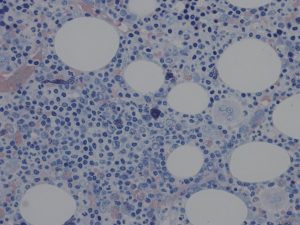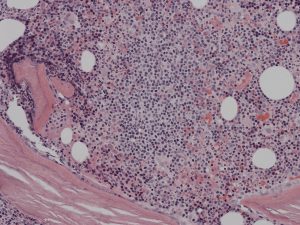The Concept of the Disease
This is a generic term used to describe a heterogeneous group of indolent B-cell lymphomas that arise from post germinal centre B-cells. The term marginal zone is a reference to the classical pattern of infiltration of lymph nodes and spleen. This is distinguished from primary extranodal marginal zone lymphoma, which arises at sites outside the normal lymphoid system and is biologically and clinically distinct.
How is it Diagnosed?
Bone Marrow
- Nodular and diffuse infiltrate containing a variable proportion of small lymphocytes, plasma cells and other lymphocytes with varying morphology. In some case the cells have prominent cytoplasmic projections. Increased numbers of mast cells are almost always present.
- Complex immunophenotype defined partly by exclusion of other chronic lymphoproliferative disorders such as CLL or mantle cell lymphoma.
Bone Marrow Trephine Morphology



Lymph Node and Spleen
- Early involvement of nodal or splenic tissue shows localisation to the B-cell marginal zones. This later becomes more diffuse.
Pattern of Disease
- Splenic and bone marrow disease is the most common.
- Disease localised to lymph node is relatively rare.
- Many patients have an IgM paraprotein and this can be an important element in the clinical presentation and a factor determining clinical outcome.
What is the Clinical Outcome?
The majority of patients require treatment and about 50% survive 5 years.
This is a complex group of disorders with considerable variation in phenotype and overlapping patterns of clinical disease. It is likely that a more definitive classification will emerge that will improve the assessment of prognosis.

